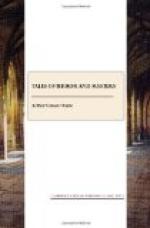I observed this morning that among the numerous tufts of sheep’s wool which lay among the bushes near the cavern there was one which was smeared with blood. Of course, my reason tells me that if sheep wander into such rocky places they are likely to injure themselves, and yet somehow that splash of crimson gave me a sudden shock, and for a moment I found myself shrinking back in horror from the old Roman arch. A fetid breath seemed to ooze from the black depths into which I peered. Could it indeed be possible that some nameless thing, some dreadful presence, was lurking down yonder? I should have been incapable of such feelings in the days of my strength, but one grows more nervous and fanciful when one’s health is shaken.
For the moment I weakened in my resolution, and was ready to leave the secret of the old mine, if one exists, for ever unsolved. But tonight my interest has returned and my nerves grown more steady. Tomorrow I trust that I shall have gone more deeply into this matter.
April 22.—Let me try and set down as accurately as I can my extraordinary experience of yesterday. I started in the afternoon, and made my way to the Blue John Gap. I confess that my misgivings returned as I gazed into its depths, and I wished that I had brought a companion to share my exploration. Finally, with a return of resolution, I lit my candle, pushed my way through the briars, and descended into the rocky shaft.
It went down at an acute angle for some fifty feet, the floor being covered with broken stone. Thence there extended a long, straight passage cut in the solid rock. I am no geologist, but the lining of this corridor was certainly of some harder material than limestone, for there were points where I could actually see the tool-marks which the old miners had left in their excavation, as fresh as if they had been done yesterday. Down this strange, old-world corridor I stumbled, my feeble flame throwing a dim circle of light around me, which made the shadows beyond the more threatening and obscure. Finally, I came to a spot where the Roman tunnel opened into a water-worn cavern—a huge hall, hung with long white icicles of lime deposit. From this central chamber I could dimly perceive that a number of passages worn by the subterranean streams wound away into the depths of the earth. I was standing there wondering whether I had better return, or whether I dare venture farther into this dangerous labyrinth, when my eyes fell upon something at my feet which strongly arrested my attention.
The greater part of the floor of the cavern was covered with boulders of rock or with hard incrustations of lime, but at this particular point there had been a drip from the distant roof, which had left a patch of soft mud. In the very centre of this there was a huge mark—an ill-defined blotch, deep, broad and irregular, as if a great boulder had fallen upon it. No loose stone lay near, however,




